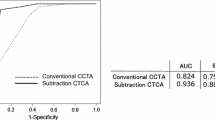Abstract
Multi-detector-row CT angiography (CTA) is a new technology that allows for non-invasive investigation of coronary atherosclerosis in patients. The relation between the morphology of atherosclerotic plaques assessed by CTA and histopathology is unknown. We investigated 11 human cadaver heart specimens. A mixture of methylcellulose and CT contrast media was injected into the coronary arteries to achieve in-vivo-like contrast enhancement within the coronary artery lumen. The morphologic pattern of atherosclerotic lesions found on CTA images and the tissue attenuation of non-calcified plaques were determined. After CTA imaging, atherosclerotic lesions in the coronary arteries were macroscopically identified and characterized histopathologically according to American Heart Association criteria. A total of 50 and 40 lesions were found macroscopically and by CTA, respectively. Thirty-three lesions could have been compared directly. The sensitivity of CTA compared with macroscopic detection of atheromas, fibroatheromas, fibrocalcified, and calcified lesions was 73, 70, 86, and 100%, respectively. The mean CT attenuation of predominantly lipid-rich and fibrous-rich plaques was significantly different (47±9 and 104±28 HU, respectively; p<0.01). Atherosclerotic coronary plaques detected by CTA may represent different stages of coronary atherosclerosis. The tissue attenuation of non-calcified plaques may allow for assessment of their predominant component.


Similar content being viewed by others
References
Pasterkamp G, Falk E, Woutman H, Borst C (2000) Techniques characterizing the coronary atherosclerotic plaque: influence on clinical decision making? Am J Cardiol 36:13–21
Huang H, Virmani R, Younis H, Burke A, Kamm R, Lee R (2001) The impact of calcification on the biomechanical stability of atherosclerotic plaques. Circulation 103:1051–1056
Becker CR, Knez A, Ohnesorge B, Schoepf UJ, Reiser MF (2000) Imaging of noncalcified coronary plaques using helical CT with retrospective ECG gating. Am J Roentgenol 175:423–424
Schroeder S, Kopp A, Baumbach A et al. (2001) Noninvasive detection and evaluation of atherosclerotic coronary plaque with multislice computed tomography. J Am Coll Cardiol 37:1430–1435
Kajinami K, Seki H, Takekoshi N, Mabuchi H (1997) Coronary calcification and coronary atherosclerosis: site by site comparative morphologic study of electron beam computed tomography and coronary angiography. J Am Coll Cardiol 29:1549–1556
Stary HC, Chandler AB, Dinsmore RE et al. (1995) A definition of advanced types of atherosclerotic lesions and a histological classification of atherosclerosis. A report from the Committe on Vascular Lesions of the Council on Atherosclerosis, American Heart Association. Circulation 92:1355–1374
Schermund A, Rumberger J, Colter J, Sheedy P, Schwarz R (1998) Angiographic correlates of "spotty" coronary artery calcium detected by electron-beam computed tomograpy in patients with normal or near-normal coronary angiograms. Am J Cardiol 82:508–511
Virmani R, Kolodgie FD, Burke AP, Frab A, Schwartz SM (2000) Lessons from sudden coronary death. A comprehensive morphological classification scheme for atherosclerotic lesions. Aterioscler Thromb Vasc Biol 20:1262–1275
Estes J, Quist W, Lo Gerfo F, Costello P (1998) Noninvasive characterization of plaque morphology using helical computed tomography. J Cardiovasc Surg 39:527–534
Baumgart D, Schmermund A, George G et al. (1997) Comparison of electron beam computed tomography with intracoronary ultrasound and coronary angiography for detection of coronary atherosclerosis. J Am Coll Cardiol 30:57–64
Nierman K, Cademartiri F, Lemos P, Raaijmakers R, Pattynama P, de Feyter P (2002) Reliable noninvasive coronary angiography with fast submillimeter multislice spiral computed tomography. Circulation 196:2051–2054
Hong C, Becker CR, Huber A et al. (2001) ECG-gated reconstructed multi-detector row CT coronary angiography: effect of varying trigger delay on image quality. Radiology 220:712–717
Author information
Authors and Affiliations
Corresponding author
Rights and permissions
About this article
Cite this article
Becker, C.R., Nikolaou, K., Muders, M. et al. Ex vivo coronary atherosclerotic plaque characterization with multi-detector-row CT. Eur Radiol 13, 2094–2098 (2003). https://doi.org/10.1007/s00330-003-1889-5
Received:
Accepted:
Published:
Issue Date:
DOI: https://doi.org/10.1007/s00330-003-1889-5




